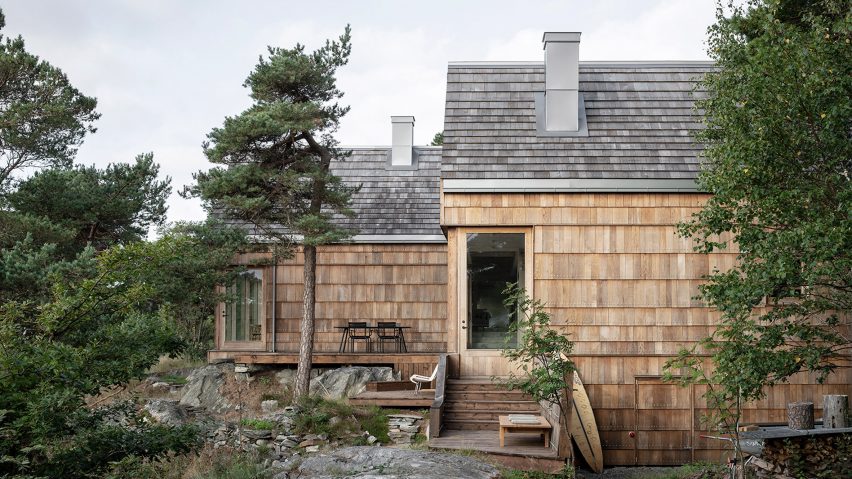Kolman Boye Architects has completed a weekend retreat in Lillesand, Norway, with a facade made from offcuts of wooden flooring material.
Architects Erik Kolman and Victor Boye, founders of Stockholm-based Kolman Boye, came up with the design after discovering that Danish flooring brand Dinesen had a large volume of leftover wood available for use.
Using oak offcuts, they developed a cladding system that could effectively cover the walls and the roof of the timber-framed Saltviga House.
This led to the project being nicknamed "the house of offcuts".
"It's about using what's available, of trying to find beautiful materials without clicking 'order' on a computer," said Boye.
"When you look at old houses, they would always be built from the best materials available in close proximity," he told Dezeen. "We wanted to explore how this thinking might look today."
The house is located on the seafront, on a rocky site where the owners – a family with children – previously had another holiday home.
Although the architects had initially hoped to upgrade the original structure, the condition was too bad to make this possible.
They instead planned a new single-storey house that follows the original footprint, but is set over five different levels that work with the site's natural topography.
The decision to use offcuts came early on. Boyes had already been working with students at the Royal Danish Academy to explore new uses for this material after Dinesen had approached him with the idea.
This got him thinking about whether this waste material could be used at an architectural scale. Dinesen loved the idea and offered to supply enough wood to make it possible.
"Dinesen is an old family company that, from generation to generation, has been working to the idea of utilising all the pieces of the tree trunk," said Hans Peter Dinesen, who shares his name with Dinesen's founder, his great-great grandfather.
"Offcuts are something that will always be available, so we try to be curious about how to use this material in new ways," he added.
Kolman and Boye, along with project architect Asger Højlund, built a series of full-scale protoypes to help them understand the most efficient and practical way of layering the oak offcuts.
Rather than applying the wood randomly, as you might with shingles, they settled on a single-layer stacking that creates linear bands of various different heights.
"We tried stacking in different ways to help us understand how much material we would need, how it would look, and how much work would be involved to cut it to size and treat it," said Kolman.
Despite the tests, the architects were surprised by the variety of colour tones created in the completed building.
"Although in time they will turn grey, at the moment you have all these fantastic colours intermingling, which is fantastic," said Kolman.
The house is formed of two main blocks, with a connecting corridor.
One block provides a large kitchen and dining space, while the other contains three bedrooms, a bathroom, a loft and an informal lounge space.
"We tend to break our houses down into smaller volumes, so that they're more nimble to organise in the landscape," said Boye.
Wood plays an important role inside as well as outside. Most of the interior is built from Douglas fir, including a kitchen where cabinet fronts are formed of more Dinesen material offcuts.
In total, approximately 12,000 offcuts were used across the entire building.
The gabled roof profiles create dramatic angular ceilings in the living spaces, while expansive windows are positioned to take full advantage of the sea and landscape views.
Patio decks are dotted around the building, so residents can enjoy the sun at different times of day, while wood-burning stoves create cosy places where the family can gather when the temperature drops.
The project has a lot in common with Vega Cottage, a Norwegian retreat designed by Kolman Boye to resemble weather-beaten traditional boathouses.
But while both buildings celebrate wood construction, Saltviga House offers a more poignant reminder that all materials come with an environmental cost that should be considered.
"It's about using all the resources in a beautiful way," added Boye.
"There's a frugality to it, in being curious to use something we wouldn't use usually," he continued.
"We need to be aware that materials are not endless resources, they are scarce. So we need to make them work for a long time and in a beautiful way."
Other recent Norwegian residential projects include a timber holiday cabin by Rever & Drage and an "invisible villa" hidden under a green roof.
The photography is by Johan Dehlin.
Project credits:
Architect: Kolman Boye Architects
Engineer: Limträteknik
Builder: Byggmester Modalen

